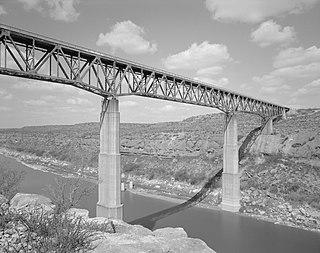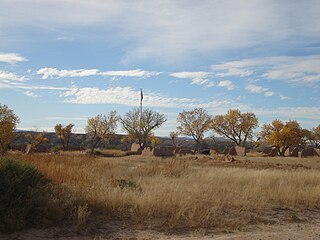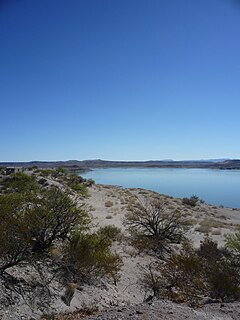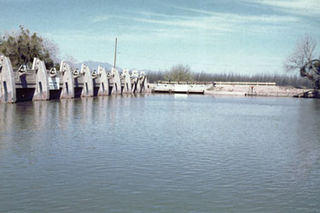| Leasburg Dam State Park | |
| New Mexico State Park | |
| Country | United States |
|---|---|
| State | New Mexico |
| County | Doña Ana |
| Location | Las Cruces |
| - elevation | 4,200 ft (1,280 m) |
| - coordinates | 32°29′49″N106°55′22″W / 32.49694°N 106.92278°W Coordinates: 32°29′49″N106°55′22″W / 32.49694°N 106.92278°W |
| Area | 293 acres (119 ha) |
| Founded | 1971 [1] |
| Management | New Mexico State Parks Division |
| Owner | U.S. Bureau of Reclamation [1] |
Leasburg Dam State Park is a state park of New Mexico, United States, located on the Rio Grande. It provides opportunities for camping, hiking, picnicking, swimming, and wildlife viewing. Nearby is the historic Fort Seldon State Monument, and 15 miles (24 km) to the south is the city of Las Cruces.

State parks are parks or other protected areas managed at the sub-national level within those nations which use "state" as a political subdivision. State parks are typically established by a state to preserve a location on account of its natural beauty, historic interest, or recreational potential. There are state parks under the administration of the government of each U.S. state, some of the Mexican states, and in Brazil. The term is also used in the Australian state of Victoria. The equivalent term used in Canada, Argentina, South Africa and Belgium, is provincial park. Similar systems of local government maintained parks exist in other countries, but the terminology varies.

New Mexico is a state in the Southwestern region of the United States of America; its capital and cultural center is Santa Fe, which was founded in 1610 as capital of Nuevo México, while its largest city is Albuquerque with its accompanying metropolitan area. It is one of the Mountain States and shares the Four Corners region with Utah, Colorado, and Arizona; its other neighboring states are Oklahoma to the northeast, Texas to the east-southeast, and the Mexican states of Chihuahua to the south and Sonora to the southwest. With a population around two million, New Mexico is the 36th state by population. With a total area of 121,592 sq mi (314,920 km2), it is the fifth-largest and sixth-least densely populated of the 50 states. Due to their geographic locations, northern and eastern New Mexico exhibit a colder, alpine climate, while western and southern New Mexico exhibit a warmer, arid climate.

The Rio Grande is one of the principal rivers in the southwest United States and northern Mexico. The Rio Grande begins in south-central Colorado in the United States and flows to the Gulf of Mexico. Along the way, it forms part of the Mexico–United States border. According to the International Boundary and Water Commission, its total length was 1,896 miles (3,051 km) in the late 1980s, though course shifts occasionally result in length changes. Depending on how it is measured, the Rio Grande is either the fourth- or fifth-longest river system in North America.
The dam at Leasburg was completed in 1908. Its purpose is not to hold back the flow of the river, but instead to divert it into a system of canals for use by nearby farms. [2]

The Leasburg Diversion Dam is a structure completed in 1907 on the Rio Grande in New Mexico, United States. It diverts water from the Rio Grande into the 13.7 miles (22.0 km) long Leasburg Canal, which carries irrigation water into the upper Mesilla Valley, north of Las Cruces, New Mexico.

Canals, or navigations, are human-made channels, or artificial waterways, for water conveyance, or to service water transport vehicles.
Known for its rich history, early settlers used the area as a passage to Jornada del Muerto, the nearby site of a 19th-century army outpost is a reminder of a time not too long ago. Leasburg Dam State Park offers year-round camping, picnicking, and birdwatching. From about mid-March to mid-October the park is also a venue for fishing, canoeing, and kayaking in the Rio Grande. The dam channels water from the Rio Grande for irrigation in the Mesilla Valley. Nearby a museum and a number of trails are located near Fort Seldon State Monument.

The name Jornada del Muerto is translated loosely from Spanish, historically referring to it as the "Journey of the Dead Man", though the modern literal translation is closer to "The Working Day of the Dead". As a geographic name, "Jornada del Muerto" is the desert region the Conquistadors had to cross to make it from Las Cruces to Socorro, New Mexico. As a name-place, "Jornada del Muerto" is a loose translations of "single day's journey of the dead man" hence "route of the dead man") in the U.S. state of New Mexico was the name given by the Spanish conquistadors to the Jornada del Muerto Desert basin, and the particularly dry 100-mile (160 km) stretch of a route through it.

Birdwatching, or birding, is a form of wildlife observation in which the observation of birds is a recreational activity or citizen science. It can be done with the naked eye, through a visual enhancement device like binoculars and telescopes, by listening for bird sounds, or by watching public webcams.

The Mesilla Valley is a geographic feature of Southern New Mexico and far West Texas. It was formed by repeated heavy spring floods of the Rio Grande.















